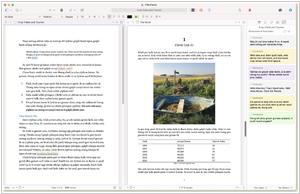Livingwriter vs Scrivener
Last updated: October 21, 2023
LivingWriter and Scrivener are two popular writing software options that cater to the needs of authors, but they differ in their features and approaches to writing.
LivingWriter is a cloud-based writing tool that focuses on collaboration and organization. It offers a clean and intuitive interface with features specifically designed for collaborative writing projects. LivingWriter allows multiple authors to work on the same document simultaneously, making it ideal for co-authors or writing teams. It provides tools for outlining, storyboarding, character development, and tracking progress. LivingWriter also offers a distraction-free writing mode and integrates with popular productivity tools like Google Docs and Microsoft Word. Its emphasis on collaboration and organization makes it a suitable choice for authors who value real-time collaboration and streamlined project management.
On the other hand, Scrivener is a robust writing software known for its comprehensive organizational features. It allows authors to break down their writing into smaller, manageable sections such as chapters or scenes. Scrivener provides a virtual corkboard, where users can arrange and rearrange index cards to plan and outline their work. It offers advanced tools for research organization, note-taking, and integration with reference materials. Scrivener also supports a variety of file formats, making it versatile for different types of writing projects. Its focus on organization and research management makes it particularly useful for novelists, researchers, and non-fiction writers who require a structured approach to their work.
Another significant difference between LivingWriter and Scrivener is their platform compatibility. LivingWriter is a cloud-based tool accessible through a web browser, allowing users to access and work on their writing from any device with an internet connection. It also offers offline mode for working without an internet connection. In contrast, Scrivener is a standalone software available for Mac, Windows, and iOS. It requires installation on a specific operating system and does not offer direct cloud access. Scrivener's platform-specific nature may be preferable for users who prefer a dedicated desktop application and do not require cloud-based collaboration features.
LivingWriter is a cloud-based writing tool that focuses on collaboration and organization. It offers a clean and intuitive interface with features specifically designed for collaborative writing projects. LivingWriter allows multiple authors to work on the same document simultaneously, making it ideal for co-authors or writing teams. It provides tools for outlining, storyboarding, character development, and tracking progress. LivingWriter also offers a distraction-free writing mode and integrates with popular productivity tools like Google Docs and Microsoft Word. Its emphasis on collaboration and organization makes it a suitable choice for authors who value real-time collaboration and streamlined project management.
On the other hand, Scrivener is a robust writing software known for its comprehensive organizational features. It allows authors to break down their writing into smaller, manageable sections such as chapters or scenes. Scrivener provides a virtual corkboard, where users can arrange and rearrange index cards to plan and outline their work. It offers advanced tools for research organization, note-taking, and integration with reference materials. Scrivener also supports a variety of file formats, making it versatile for different types of writing projects. Its focus on organization and research management makes it particularly useful for novelists, researchers, and non-fiction writers who require a structured approach to their work.
Another significant difference between LivingWriter and Scrivener is their platform compatibility. LivingWriter is a cloud-based tool accessible through a web browser, allowing users to access and work on their writing from any device with an internet connection. It also offers offline mode for working without an internet connection. In contrast, Scrivener is a standalone software available for Mac, Windows, and iOS. It requires installation on a specific operating system and does not offer direct cloud access. Scrivener's platform-specific nature may be preferable for users who prefer a dedicated desktop application and do not require cloud-based collaboration features.
63
LivingWriter is book writing software designed for fiction authors. It features a standard word processor alongside a suite of planning and plotting features.
64
Scrivener is the go-to app for writers of all kinds, used every day by best-selling novelists, screenwriters, non-fiction writers, students, academics, lawyers, journalists, translators and more. Scrivener won't tell you how to write—it simply provides everything you need to start writing and keep writing.
Livingwriter vs Scrivener in our news:
2022. LivingWriter brings its mobile apps in line with our web/desktop versions
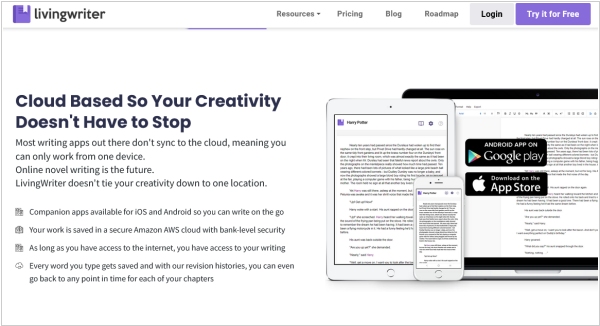
LivingWriter mobile app for iOS/Android was created as a companion app for quick on-the-go writing, so it’s missing quite a few features available on our web/desktop versions. But with new upgrade, the mobile app will be updated to include ALL the features of our web/desktop versions. The new version also includes a fresh new (but not unfamiliar) design with the latest UI/UX technology and a zippier interface, in addition to various customization options. Added layers of security like 2FA and password locks on stories/folders are coming soon. With more export options added and the ability to produce Kindle-Ready and KDP formatted files. The new Device Preview feature will allow you to see your book across multiple devices. Along with this, LivingWriter has also redesigned sharing feature with tools such as tracking changes, live collaboration, live commenting, and more.
2021. LivingWriter has introduced the Research Board
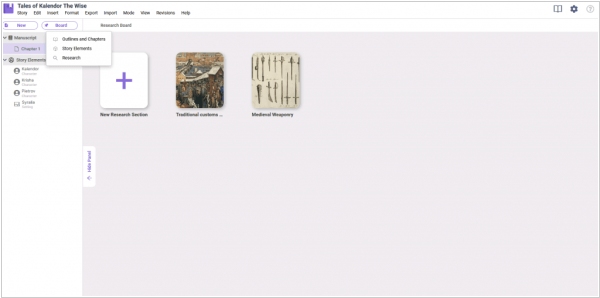
LivingWriter's newest feature, the Research Board, serves as a tool to research important matters related to a story. For instance, it could be used to research cultural characteristics of a particular region, political and economic structures of a feudal society for a medieval fantasy novel, and other related research. The Research Board provides a separate space for writers to work on their research, eliminating the need to use general-purpose features like Story notes or Global notes, or even a separate notebook or app, especially when working on research-intensive projects like a Ph.D. thesis. The Research Board allows writers to add and organize their research neatly within the app.
2021. Scrivener 3 for Windows gets simple and beautiful interface
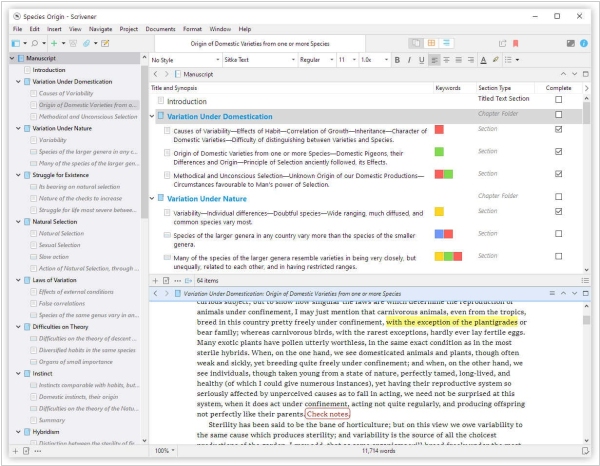
The latest version of Scrivener 3 is now available on Windows, bringing with it a variety of new and improved features. The update includes a modernized and simplified interface, a redesigned and more flexible Compile feature, and a full styles system in the text system. Other enhancements include the ability to view index cards on colored threads, improved ebook export, and the addition of Writing History to track daily writing progress. Custom Metadata has also been improved, allowing for checkboxes, dates, and list boxes to be added to the Inspector and outliner. Additional features include enhanced outlining, a new Quick Search tool, progress bars, and a Dark Mode, among others. The Bookmarks feature also replaces Project Notes, References, and Favorites, making it easier to access frequently used documents. Furthermore, the Dialogue Focus feature allows users to easily locate all dialogue within their text.
2020. LivingWriter now allows to set writing goals for your story

LivingWriter has unveiled a new feature called Writing Goals that allows users to set word count targets for individual chapters or the entire story. By establishing a deadline for completing the story or chapter, LivingWriter automatically computes the daily word goal required to achieve the ultimate target. Users can also take days off, and the program will distribute the daily word count evenly over their writing days. This feature is particularly beneficial for those with deadlines such as the National Novel Writing Month competition, which requires participants to finish their novels in a month. However, even if there is no deadline, setting goals is still critical for personal progress.
2020. Livingwriter now allows to upload book cover art
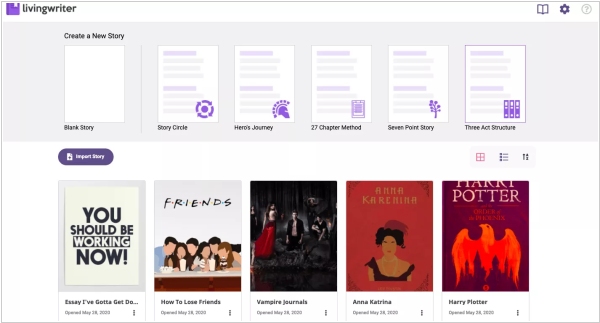
Online book writing software LivingWriter has introduced a new feature that allows users to upload book cover art to all their stories. For those who are not ready to publish yet but want to visualize their book as a final product, Canva is a great website that provides free and customizable book cover templates. To get started, search for best-selling books that are similar to the type of book you're writing and collect images of the ones you love the most. Then head over to Canva and select a book cover template that follows the same theme as your book. Customize the title, colors, spacing, and images using Canva's own images, some of which may cost a dollar or two, or free professional images from a site like unsplash.com. This is a great way to inspire yourself and visualize your book as a finished product.
2019. Scrivener for iOS adds support for many more screen types
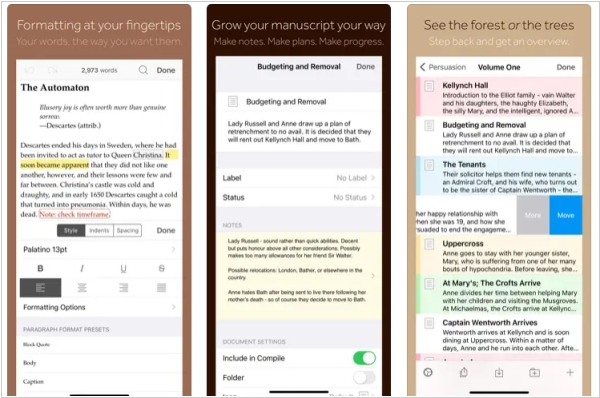
The latest version of Scrivener for iOS, version 1.2, is now available to download from the App Store and offers support for iOS 13, improved compatibility with a wider range of screen types, and seamless integration with iOS 13's dark mode. Alongside these enhancements, existing features of the app include the ability to write and organize your manuscript in sections of any size, view all sections as a single text, navigate sections quickly using the binder sidebar, format with fonts and presets, and use comments, footnotes, links, highlights, simple bullets, and lists. Additionally, the app allows you to insert images, resize text with pinch-zoom, use full-screen and typewriter scrolling modes (iPad only), write a screenplay using scriptwriting mode, check live word and character counts, set targets for word and character counts, find and replace text, and customize the keyboard row and shortcuts for external keyboard users.
2018. Scrivener for macOS adds Dark mode and Scriptwriting

Scrivener 3.1 is a major update for macOS that introduces a number of new features and enhancements. One notable addition is full support for dark mode on macOS 10.14, which allows you to take full control over colors and UI in each mode. Scrivener 3.1 also offers scriptwriting improvements, such as support for "MORE" and "CONT'D" when compiling for PDF and printing, dual dialogue support, and an option to not split sentences across pages in scripts. Enhancements to Compile include the ability to include a cover image when compiling to PDF, improved options for compiling for print-on-demand services, and direct formatting for Epub 3 and Kindle KF8 formats. Additionally, a new "focus mode" is available to fade out everything except the current line, sentence, or paragraph as you write.
2017. Scrivener 3 for macOS gets Compile feature
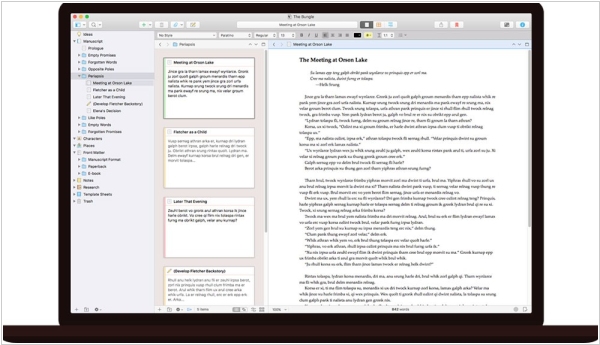
Scrivener 3 is now available for macOS starting at $59.99. Scrivener 3 is a significant update that not only introduces new and exciting features but also enhances and simplifies the existing ones. The update includes several notable improvements such as a modernized interface, a more flexible and easier-to-use Compile feature, and a full styles system in the text system that is more powerful with the new Compile. Additionally, users can view index cards on colored threads to track different storylines and filter Corkboard and outliner. Other enhancements include improved metadata, the ability to track daily writing progress with Writing History, and the new Quick Search tool to find any document quickly. The Bookmarks feature replaces Project Notes, References, and Favorites, allowing users to access frequently used documents easily. Furthermore, users can now use "Dialogue Focus" to locate all dialogue within their text and export rich text to MultiMarkdown or Pandoc. Scrivener 3 also broadens support for technical formats via Markdown output and custom post-processing. The macOS version has extensive Touch Bar support and a rewritten 64-bit codebase that makes Scrivener faster, more stable, and future-ready.


